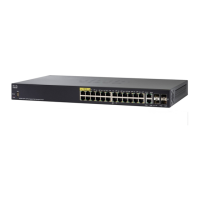User Interface Commands
1237 Cisco Sx350 Ph. 2.2.5 Devices - Command Line Interface Reference Guide
66
Syntax
banner login
d message-text d
no banner login
Parameters
• d—Delimiting character of user’s choice—a pound sign (#), for example.
You cannot use the delimiting character in the banner message.
• message-text—Message text. The message must start on a new line. You
can enter multi-line messages. You can include tokens in the form of
$(token) in the message text. Tokens are replaced with the corresponding
configuration variable (see User Guidelines). The message can contain up
to 1000 characters (after every 510 characters, you must press <Enter> to
continue).
Default Configuration
Disabled (no Login banner is displayed).
Command Mode
Global Configuration mode
User Guidelines
Follow this command with one or more blank spaces and a delimiting character of
your choice. Then enter one or more lines of text, terminating the message with
the second occurrence of the delimiting character.
Use tokens in the form of $(token) in the message text to customize the banner. The
tokens are described in the table below:
Token Information displayed in the banner
$(hostname) Displays the host name for the device.
$(domain) Displays the domain name for the device.
$(bold) Indicates that the next text is a bold text. Using this
token again indicates the end of the bold text.
$(inverse) Indicates that the next text is an inverse text. Using this
token again indicates the end of the inverse text.
$(contact) Displays the system contact string.

